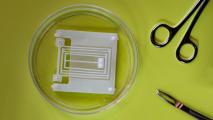This article is an installment of The Future Explored, a weekly guide to world-changing technology. You can get stories like this one straight to your inbox every Thursday morning by subscribing here.
This month, Stanford researchers brought us one step closer to artificial skin with embedded electronics that can flex and bend with the body.
It’s a vision of a future in which wearable and implantable technology can be worn seamlessly every day, from fashion to medicine.
For nearly two decades, Stanford professor and chemical engineer Zhenan Bao has made incredible progress toward this dream — but now it has been hampered by a practical reality: the ability to mass-produce completely new products.
“How does one produce a completely new technology in quantities great enough to make commercialization possible?” Bao said in a statement.
Now: In a new study published in Science, Bao and her team have demonstrated a way to print their stretchable circuits on rubbery, “skin-like” materials — with the same equipment currently used to produce silicon chips.
“It’s the first step toward a world in which bioelectronics are commonplace.”
It’s a process known as photolithography, used by the semiconductor industry for decades. It uses ultraviolet light to transfer a circuit onto a solid substrate, layer by layer. An unfortunate side effect of this process, though, is that the chemicals will also wash away the materials that are the foundation for Bao’s stretchable circuits.
Bao and her team’s breakthrough is new photochemistries that don’t wash away these materials. They hope that doing so eases the financial burden to commercializing stretchable electronics.
“With improvements in transistor density, this process could lead to new applications for flexible circuitry,” said Donglai Zhong, a postdoctoral fellow and co-first author on the study.
Present and future: In the study, Bao’s team was able to squeeze 40,000 transistors in 1 sq. cm of stretchable circuitry — and they believe they could double that number in the near future.
“Our method improves elastic-transistor density by more than 100 times what anyone else has achieved so far,” said Yu-Qing Zheng, a postdoctoral researcher and co-first author of the paper. “And it does it with excellent uniformity in the transistors while sacrificing nothing in electronic or mechanical performance.”
40,000 or even 80,000 transistors may sound like a lot, but billions of transistors can fit in the equivalent area in current solid silicon chips. Still, what Bao’s team has accomplished would be enough to create simple on-skin sensors, and even body-sized networks.
It’s the first step toward a world in which bioelectronics are commonplace. Such mass-produced stretchable circuitry could prompt a new wave of wearable technologies that range from new fashion styles to better sports and fitness data.
There are also important health and accessibility applications here. In one powerful example, Bao explained how wearable electronics could allow those with prosthetic limbs to feel again.
Others are hopeful that electrical signals from implantable technologies could help reduce inflammation that occurs in conditions like rheumatoid arthritis and Crohn’s disease.






